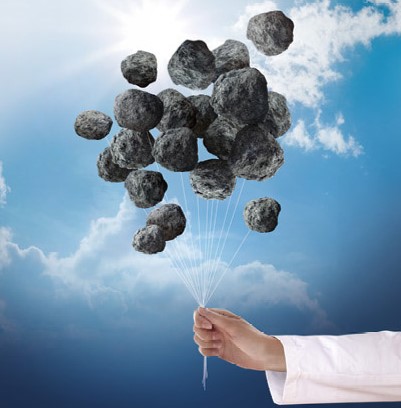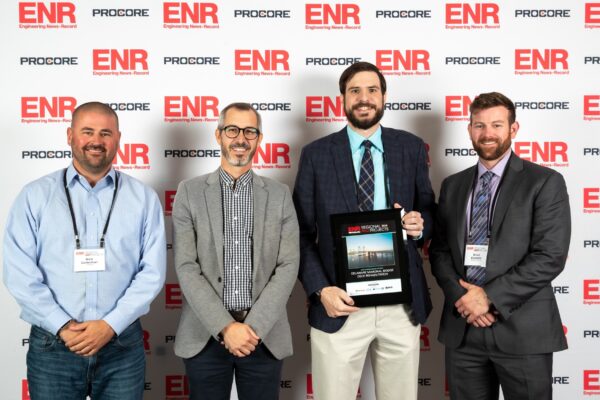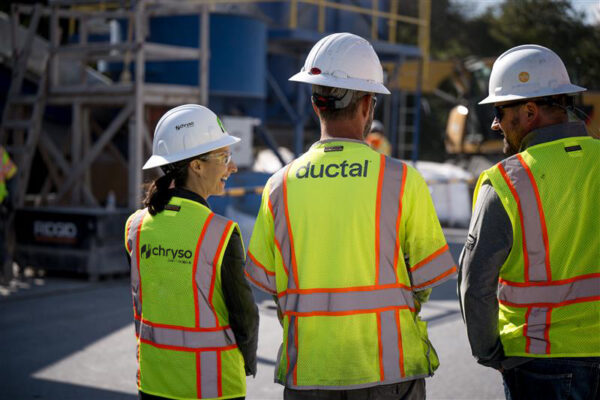Using the ADVA® Cast 555 Superplasticizer – TB-1507

ADVA® Cast 555 is a polycarboxylate-based superplasticizer developed to enable the reliable production of self-consolidating concrete (SCC), primarily in pre-cast/pre-stress (PC/PS) environments. It produces a concrete with excellent segregation resistance, filling ability and passing ability. Additionally, SCC made with ADVA® Cast 555 exhibits low-water sensitivity (high-water tolerance), enabling it to tolerate the small variations in batch-to-batch moisture normally encountered in concrete production. ADVA® Cast 555 meets the performance requirements of ASTM C494 Type F high-range water reducer.
Local Pre-Production Testing
All admixtures will perform differently with different concrete making materials. Before ADVA® Cast 555 is used in everyday concrete production, We strongly recommend that it be tested in all mix designs where it will be used, using actual job materials. If concrete making materials or ambient conditions change, testing should again be performed and any necessary adjustments made prior to commencing commercial production.
Plastic Concrete Properties
Today, it is possible to consistently produce quality SCC if great care is taken to minimize variability in materials and processes (see TB-1505 for details). While the use of ADVA® Cast 555 does not eliminate the need to impose tighter control limits on SCC than on conventional concrete, its use does make the concrete more tolerant of normal variations. In some cases the use of ADVA® Cast 555 may even enable the production of satisfactory SCC under less-than-optimum conditions, such as with less-than-ideal aggregate gradations, or lower-than-optimum powder contents, or variable material properties (such as aggregate moisture). Self-consolidating concrete made using ADVA® Cast 555 exhibits some rather unique plastic properties that will be discussed in greater detail below.
Slump Flow
ADVA® Cast 555 disperses easily in the concrete, and builds slump flow rather quickly. If the concrete is sampled and tested after a short mix cycle, one will find the desired slump flow and entrained air, but the concrete may be lacking stability, as noted by a high visual stability index (VSI). Lengthening the mix times allow the ADVA® Cast 555 components to build “body” into the concrete, and enhance its resistance to segregation. Therefore, if after the initial mixing the VSI is not acceptable, a longer mix cycle should be tried before making more severe changes to the mix design. SCC made with ADVA® Cast 555 exhibits less stickiness than concretes made with other polycarboxylate-based products. This means that the concrete will flow farther and more quickly, simplifying the placement operation and decreasing placement time. This property can also be used to advantage by making concrete with a lower slump flow than would be required with other products, thus reducing the tendency of the concrete to segregate. ADVA® Cast 555 was not designed with the ability to maintain the initial slump flow for the extended periods of time, between batching and placement, encountered in many ready-mix applications. As a result its use should be limited to PC/PS environments.
Water Sensitivity
The way ADVA® Cast 555 builds “body” into the concrete, and enhances its stability, is one of its most unique attributes. This property also makes fine-tuning a mix design a little more difficult than with other admixtures.
The way to increase slump flow in a concrete treated with ADVA® Cast 555 is to add all the needed water during the initial batching sequence. Once the concrete has been thoroughly mixed, and the ADVA® Cast 555 begins to increase its stability-enhancing “body”, it will be difficult to increase slump flow by re-tempering with water. At this stage the concrete is able to absorb modest amounts of water without significantly affecting the slump flow.
In the table below (Example 1), the effect of repeated re-tempering the SCC with water can be seen. Repeated additions of water resulted in a fairly unmoving slump flow, when tested as per ASTM C1611. The concrete remained very stable, and the VSI remained at 0 (zero) throughout. The one obvious change in the concrete was a reduction in its viscosity, as evidenced by a steady decrease in T500 (T20) with increasing water content. Thus, although the measured slump flow of the SCC did not change, its ability to flow and thoroughly fill forms is enhanced.
Example 1: Water Tolerance
| Plastic Concrete Sample* | 1 | 2 | 3 | 4 |
| Cementitious powder, kg/m3 (lb/yd3) | 421 (710) | — | — | — |
| 9.5 mm (3⁄8 in.) stone, kg/m3 (lb/yd3) | 919 (1550) | — | — | — |
| Sand, kg/m3 (lb/yd3) | 786 (1325) | — | — | — |
| Initial water, kg/m3 (lb/yd3) | 147.7 (249) | — | — | — |
| Added water, kg/m3 (lb/yd3) | — | 6.5 (11) | 6.5 (11) | 6.5 (11) |
| Total water, kg/m3 (lb/yd3) | 147.7 (249) | 154.2 (260) | 160.7 (271) | 167.3 (282) |
| W/Cm | 0.351 | 0.366 | 0.382 | 0.397 |
| AEA admixture, mL/m3 (oz/yd3) | 65 (1.7) | — | — | — |
| ADVA® CAST 555, mL/m3 (oz/yd3) | 3850 (99.5) | — | — | — |
| Slump flow, mm (in.) | 510 (20.0) | 530 (21.0) | 520 (20.5) | 510 (20.0) |
| T500 (T20), sec | 7.7 | 6.0 | 4.4 | 2.5 |
| VSI | 0 | 0 | 0 | 0 |
| Entrained air, % | 6.8 | 7.0 | 7.0 | 7.4 |
* The concrete was sampled and tested initially, and then again after each addition of water. It should be noted that even with all the mixing and extra added water, air content of the SCC remains fairly constant during the entire test.
When developing a mix design requiring a specific slump flow, rather than determining the appropriate water content by continuing to make water adjustments to one batch, it will be necessary to fabricate separate batches with varying amounts of water. Although this may initially be viewed as an undesirable complexity, the payback comes from the very consistent day-to-day production of SCC, enabled by the use of ADVA® Cast 555.
Air Entrainment
ADVA® Cast 555 is formulated with a unique air control package that permits the use of more traditional quantities of air-entraining admixtures. This results in better air management in the concrete, and once the desired dose is determined, concrete can be made with very low batch-to-batch variability in plastic air content. In fact, changes in slump flow as a result of changes in water content will have little, if any, appreciable effect on the amount of entrained air. Another benefit is that extended mix times, as a result of unexpected production delays, will result in the entrained air content remaining essentially unchanged.
If in trying to increase the slump flow of SCC, the ADVA® Cast 555 dosages are increased, higher dosages of AEA will also be required. As the ADVA® Cast 555 dosages get as high as around 1630 mL/100 kg (25 oz/100 lb) of cement, or higher, the dosage rates of air-entraining admixture can get much higher than normal.
Hardened Concrete Properties
The ability of ADVA® Cast 555 to make very stable SCC results in a very homogeneous hardened concrete.
Compressive Strength
When using SCC that exhibits segregation during testing, it may be possible to cast test specimens that are not representative of the bulk concrete. Likewise, a cast structure will not be homogeneous throughout. It is clear that under these circumstances, tested compressive strengths may show greater than expected variability, although with over-designed mixtures, this may not be an obvious issue.
The concrete homogeneity imparted by ADVA® Cast 555 translates to very consistent strengths from batch-to-batch and throughout the structure being cast. This enhanced stability may also make it possible to reduce powder contents, without sacrificing SCC quality.
The enhanced homogeneity of SCC treated with ADVA® Cast 555 is conducive to rapid and reproducible concrete strength gain. This often manifests itself in higher compressive strengths versus other polycarboxylate-based admixtures.
Example 2 highlights the increased SCC compressive strengths generated by ADVA® Cast 555 in two different concretes.
Example 2: Physical Properties
| SCC Mix Proportions & Physical Properties | Moderate Powder Content | Low Powder Content | ||
| Reference | ADVA® Cast 555 | Reference | ADVA® Cast 555 | |
| Cementitious powder, kg/m3 (lb/yd3) | 414 (698) | 409 (689) | 349 (589) | 349 (589) |
| 12.5 mm (1⁄2 in.) stone, kg/m3 (lb/yd3) | 854 (1439) | 858 (1447) | 851 (1434) | 844 (1423) |
| Sand, kg/m3 (lb/yd3) | 834 (1406) | 843 (1421) | 949 (1600) | 955 (1610) |
| Total water, kg/m3 (lb/yd3) | 200 (337) | 198 (334) | 176 (297) | 174 (293) |
| W/Cm | 0.483 | 0.485 | 0.504 | 0.497 |
| AEA admixture, mL/m3 (oz/yd3) | 23 (0.6) | 116 (3.0) | 352 (9.1) | 620 (16.0) |
| PC-based HRWR, mL/m3 (oz/yd3) | 2321 (60) | 3520 (91) | 1369 (35.4) | 2475 (64.0) |
| Slump Flow, mm (in.) | 530 (21.0) | 520 (20.5) | 610 (24.0) | 550 (21.5) |
| VSI | 0.5 | 0 | 1 | 0.5 |
| T500 (T20), sec | 5.8 | 3.1 | 4.4 | 8.0 |
| Entrained air, % | 7.5 | 7.2 | 9.0 | 8.4 |
| 1 day compressive strength, MPa (psi) | 15.0 (2170) | 17.4 (2530) | 13.2 (1920) | 15.7 (2280) |
| 7 day compressive strength, MPa (psi) | 26.5 (3840) | 29.9 (4340) | 23.4 (3390) | 28.1 (4080) |
| 28 day compressive strength, MPa (psi) | 33.7 (4890) | 36.5 (5290) | 31.0 (4500) | 33.6 (4870) |
Finish
The ability of ADVA® Cast 555 to make stable SCC with low viscosity facilitates the production of cast concrete units, particularly architectural units, by reducing or eliminating surface bungholes and honeycombs.
Admixture Addition and Sequencing
ADVA® Cast 555 should be dispensed through the water discharge line, after the AEA and other water reducers or retarders have been added, but before the “tail end” water is discharged if possible. If this is not possible, GCP Applied Technologies TB-0110, “Admixture Dispenser Discharge Line Location and Sequencing for Concrete Batching Operations,” should be consulted for other recommended options.
Conclusion
ADVA® Cast 555 offers many advantages over existing products in the production of self-consolidating concrete. Concretes tend to be more stable, produce equal or better compressive strengths, exhibit low-water sensitivity (high-water tolerance), and also exhibit excellent filling and passing ability. This can lead to the production of very high quality SCC. In some cases, ADVA® Cast 555 may even enable the production of usable SCC with less than optimum materials or production conditions. However, like all SCC production, tighter material and batching controls (versus conventional concrete) are still required. ADVA® Cast 555 may be able to smooth out some of the variability inherent in SCC production, but will not be able to overcome gross batch-to-batch variability in moisture content or aggregate gradations; its use will not replace a good quality control program and tight material controls.





